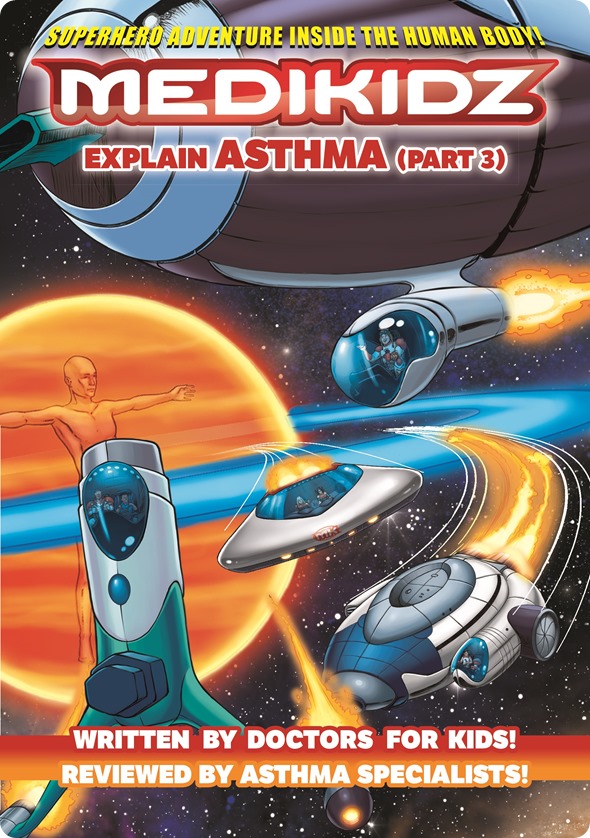How many children does asthma affect? How does asthma impact a child’s daily life?
Asthma affects about 1 in every 10 children and the prevalence seems to be increasing.
Asthma impacts children in every aspect of their daily life. It affects their sleep, daily routine and even their school activities, attendance and performance.
What are the main challenges in explaining asthma to children?
I think the main challenges in explaining asthma to children, is to make them understand that in most instances it may be a chronic condition that might need chronic daily medicine.

Can you please outline the Medikidz Explain Asthma comic book series? What are the main aims of the books?
I think the MediKidz Explain Asthma is a very good series of comic books that can make asthma more understandable to kids and will help kids understand the main points of asthma as well as some of the treatments and causes of asthma.
This comic book series is very popular with many of my patients in that it shows them some of the devices and graphically shows them how to use these treatments.

How do the comic books help children and their families better understand asthma?
It will show them how to use the medications and devices, and I think it helps to de-mystify asthma.
It makes asthma real, and yet shows them that under good control most things can be accomplished.
How were the books developed?
I understand that the series had already been done with diabetes and then was tried with asthma.
The series had already published part 2 before I became involved. Since my involvement on part 3, I have had a much better understanding of the value of the asthma series.

What feedback have you received about the books so far?
I have selected a specific age group of about 5- 12 year olds to show this series to. These kids have all enjoyed the comics for several reasons. They like the fact that they are not soft covers and they feel more like books.
They have all liked the graphics, design and colors. Of course everyone enjoys relating to a certain super hero as well.
What impact do you think the books will have on the relationship between healthcare providers, patients and families?
These comics are just one more service provided by their health care provider that will help the children and families understand that asthma is chronic, manageable and at times might cause more illness.
But with the help of a qualified health care provider that is well experienced in managing asthma, these children can and do go on to lead very productive lives with well controlled asthma.

What further tools do you think would help health care providers to better connect with asthma patients and their families?
I think some of the best tools are more discussions and face-to-face time with the patients and families.
Many times patients may not take the time to read a book or even look over the materials that are given to them.
But more in depth instructional manuals and books like these can help demonstrate to the kids how and when to use these medications. They might also let them know that many times they may get sick and need to see a HCP to help them get better.
One other tool that might help is live video demonstrations of people showing the use of medications and devices. These tend to work well, from what I have seen.
Where can readers find more information?
There are several sources that patients can seek out, there is the AAAAI, ACAAI, AAN-MA and allergy and asthma foundation. For more information on the series, readers can go to explainasthma.com.
About Gabe Ortiz
Gabriel Ortiz, MPAS, PA-C, has been a Physician Assistant in Allergy and Asthma since 1991. He has participated in numerous clinical trials for allergy and asthma medications and antibiotics.
He received his third BSc degree in Physician Assistant studies from the University of Texas Medical Branch-Galveston in 1989 and his Masters of Physician Assistant studies in Pediatric Pulmonary Medicine from the University of Nebraska Medical Center in 1999.
Gabe is Co-founder and past president of the American Academy of Physician Assistants in Allergy, Asthma and Immunology.
Gabe is the former Liaison from the American Academy of Physician Assistants (AAPA) to the American Academy of Allergy, Asthma and Immunology (AAAAI) and the AAAAI Liaison to the AAPA. He is also the former AAPA Liaison to the National Institutes of Health-National Asthma Education and Prevention Program –Coordinating Committee.
His research on the use of pharmacotherapy in the management of asthma and topics related to the treatment of allergies has appeared in Annals of Allergy Asthma and Immunology, Physician Assistant, Journal of the AAPA, Journal of Asthma, Journal of Allergy and Clinical Immunology, Advance for the PA, Advance for NP and PA, Clinical Advisor, The Journal of Family Practice and CHEST.
He has served as chair or co-chair for several PA and NP conferences and has given numerous lectures at local, state and national conferences including the AAAAI.
In February 2008, Gabe was awarded the recognition of Distinguished Fellow of the AAPA.
In March 2015, Gabe was appointed to the NIAID/NIH committee on food allergy- for the prevention of peanut allergy.